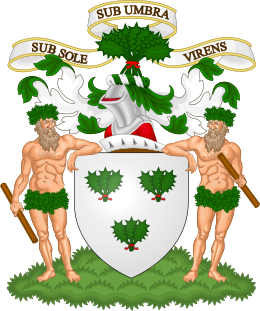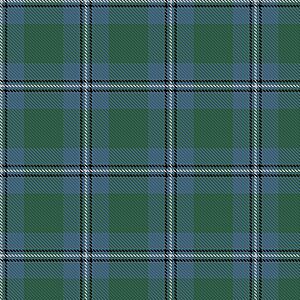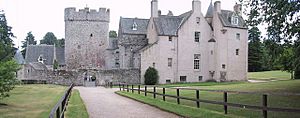Clan Irvine facts for kids
Quick facts for kids Clan Irvine |
|||
|---|---|---|---|
| Irbhinn | |||

Crest: A sheaf of Holly consisting of nine leaves Vert slipped and banded Gules.
|
|||
| Motto | SUB SOLE SUB UMBRA VIRENS (Latin: "Flourishing both in sunshine and in shade"). {Alternative Latin definition} "Green shadow beneath the sun" | ||
| Profile | |||
| Region | Aberdeenshire | ||
| Chief | |||
 |
|||
| Alexander Irvine of Drum | |||
| 27th Baron of Drum | |||
| Seat | Drum Castle | ||
|
|||
|
|||
|
|||
|
|||
The Clan Irvine is a historic Scottish family group. They have a long and interesting history in Scotland. The clan's main home has been Drum Castle in Aberdeenshire for centuries.
Contents
The Story of Clan Irvine
Where Did Clan Irvine Come From?
The first records of the Irvine name go back to the early 1100s. A person named Gilchrist, son of Erwini, was mentioned in an important document. The first lands connected to the Irvines were in an area called Dumfriesshire.
Family stories say the Irvine chiefs are linked to ancient Scottish kings. One important early Irvine was Duncan Irvine, who lived at Bonshaw. He was related to Crinan, whose family claimed to be descended from the High Kings of Ireland. Crinan's son, Duncan I of Scotland, became a King of Scotland.
A man named William de Irwin lived near the powerful Clan Bruce. The Irvines supported the Bruces. William de Irwin became the armor bearer and secretary to King Robert the Bruce. Because of his twenty years of loyal service, King Robert the Bruce gave William de Irwin the royal forest of Drum. This land was in Aberdeenshire. It then became the main home for the chief of Clan Irvine.
There was already a tower at Drum built before the late 1200s. It was a royal hunting lodge. This tower grew into Drum Castle, the seat of the clan chief.
The Clan's Crest Badge
The Irvine clan's crest badge has a special story. It comes from a time when Robert the Bruce was hiding from his enemies. William De Irwin, his secretary, stayed loyal to him. William was one of seven people who hid with Bruce in a holly bush. Their pursuers passed right by them.
When Bruce became king, he made William Master of the Rolls. Ten years after the Battle of Bannockburn, he gave William the forest of Drum. He also let William use his personal badge of three holly leaves. The motto, Sub sole sub umbra virens, means "Flourishing both in sunshine and in shade". These symbols are still part of the Irvine family's coat of arms.
Clan Conflicts in the 1400s
Clan Irvine often had disagreements with their neighbors, Clan Keith. Both clans would sometimes raid each other's lands. In 1402, Clan Irvine is said to have defeated a group of Clan Keith warriors. This happened at the Battle of Drumoak.
The third Laird of Drum was Alexander Irvine. He was the first of twelve Irvine chiefs named Alexander. He was known as a brave knight. He went with the Earl of Mar to fight in France. Later, he fought in the Battle of Harlaw in 1411. This battle was only twenty miles from Drum.
At Harlaw, Alexander Irvine fought a famous one-on-one battle. His opponent was Hector Maclean of the Battles, chief of the Clan Maclean. Both men are said to have died from their injuries. A song about the battle remembers "Gude Sir Alexander Irvine the much renounit Laird of Drum".
The 1500s and Wars with England
The next Laird of Drum was important in getting James I of Scotland released. The king had been held captive by the English. When the king was freed, de Irwyne was made a knight. After the king was killed in Perth, Sir Alexander Irvine took charge of Aberdeen. He helped to bring order back to the city.
The sixth Laird of Drum was a peacemaker. King James V of Scotland rewarded him in 1527. This was for his efforts to stop rebels, thieves, and other criminals.
During the Anglo-Scottish Wars, the sixth Laird's son was killed. This happened when the clan fought against the English. It was at the Battle of Pinkie Cleugh in 1547.
The 1600s and the Civil War
During the Civil War, the Irvines supported King Charles I. They were Royalists. However, the Irvines lived in an area where most people supported the Covenanters. So, Drum Castle was an easy target for attacks.
The castle was attacked when the Laird of Drum was away. A strong force surrounded it with cannons. Lady Irvine had to surrender. The castle was then robbed. The Laird of Drum's two sons both fought in the civil war. Both were captured. The younger son, Robert, died in Edinburgh Castle's dungeons. However, his brother, Alexander, was freed. This happened after James Graham, 1st Marquis of Montrose won the Battle of Kilsyth in 1645. Drum Castle was attacked again. It was ransacked, and the ladies of the house were forced out. The family's lands were ruined.
The 1700s and Jacobite Risings
During the Jacobite rising of 1715, the fourteenth Laird of Drum supported the Jacobite cause. He fought at the Battle of Sheriffmuir in 1715. There, he got a serious head wound. He never fully recovered and died years later without a direct heir. His uncle, John Irvine, then took over the estate. After him, another relative, John Irvine of Crimond, became the Laird.
During the Jacobite rising of 1745, Clan Irvine continued to support the Jacobite Stuarts. They fought at the Battle of Culloden in 1746. The Laird of Drum escaped capture. He hid in a secret room at Drum Castle. He then lived in France for a few years. Eventually, he was allowed to return to his estates.
The 1800s and 1900s
Colonel John Irving of Bonshaw fought in the British Expedition to Abyssinia. His son, Sir Robert Irving of Bonshaw, became a very important captain. He was commodore of the Cunard Line and captain of the famous ship HMS Queen Mary.
The twenty-second Laird of Drum fought in the Grenadier Guards during World War I.
Clan Irvine Today
In 2002, the previous Chief of Clan Irvine made a peace agreement. He met with the 13th Earl of Kintore, who was the previous Chief of Clan Keith. This special ceremony happened on the banks of the River Dee. It officially ended their 600-year-long disagreement.
Clan Chief
- The current Clan chief is Alexander Irvine of Drum, the 27th Baron of Drum.
Clan Castles
See also
- Scottish clan
- Irvine (disambiguation)



